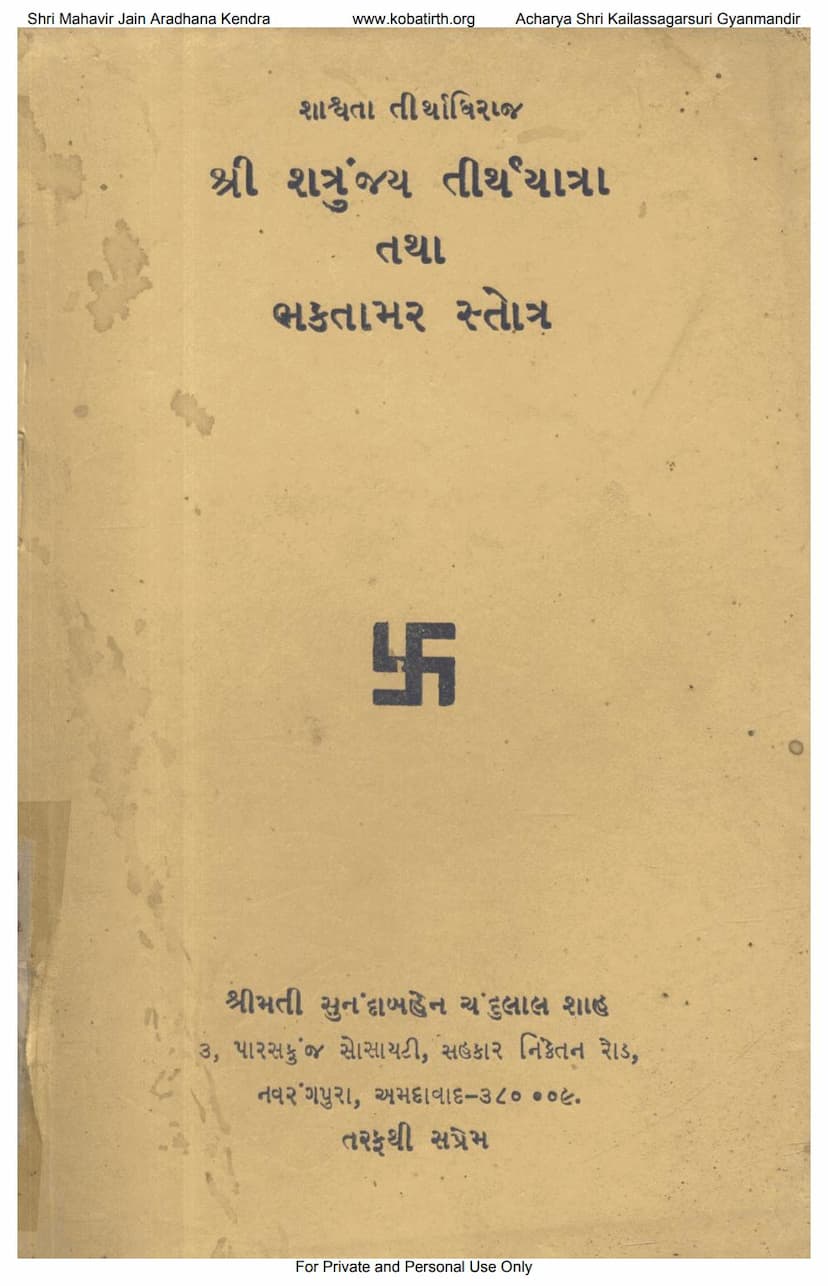Shatrunjay Tirth Yatra Tatha Bhaktamar Stotra
Added to library: September 2, 2025

Summary
Here's a comprehensive summary of the Jain text "Shatrunjay Tirth Yatra Tatha Bhaktamar Stotra" by Sunandaben C. Shah, based on the provided pages:
This book, published by Sunandaben C. Shah and associated with the Shri Mahavir Jain Aradhana Kendra and Acharya Shri Kailassagarsuri Gyanmandir, is a guide and devotional compilation for Jain pilgrims, particularly focusing on the Shatrunjay Tirth Yatra (Pilgrimage) and the Bhaktamar Stotra.
Overall Purpose and Content:
The book serves as a devotional manual, offering guidance, prayers, and hymns for performing the pilgrimage to Shatrunjay, a most sacred Jain pilgrimage site. It also includes the revered Bhaktamar Stotra, a powerful hymn attributed to Acharya Manatunga, known for its miraculous qualities.
Key Sections and Themes:
-
Introduction and Dedication (Page 1-2): The initial pages establish the book's affiliation with Jain institutions and acknowledge the author's contribution. They set a tone of reverence and devotion.
-
Core Jain Mantras and Principles (Page 3):
- Panch Namaskara (Navkar Mantra): The foundational mantra of Jainism is presented, highlighting its importance as the first and most auspicious chant.
- Qualities of the Soul: The text briefly mentions the twelve virtues or qualities that a soul can attain, emphasizing self-control, adherence to vows, and the suppression of passions.
- Names of Shatrunjay: Several revered names for Shatrunjay hill are listed, including Siddhaachal, Pundarikgiri, Shatrunjaygiri, Kanchan-giri, and Chitrakut, emphasizing its sacredness and grandeur. The invocation is made to Lord Rishabhadeva (Adinath) and Shatrunjay.
-
Devotional Chants and Prayers for Shatrunjay (Page 4-10):
- Praise and Glorification of Shatrunjay: The text expresses deep adoration for Shatrunjay, describing it as a place where immense souls have attained liberation (Siddha). The belief that every stone on Shatrunjay is sacred and liberates from suffering is conveyed.
- Chaitra Vandan (Temple Worship): Prayers for worshipping the idols are included, with offerings of golden and silver flowers and sincere devotion. The purity of the mind and body achieved through worship is highlighted. The idea that even those with little spiritual inclination can experience divine presence through dedicated worship is mentioned. The text emphasizes the spiritual merit gained by worshipping the Siddh (liberated souls) and the Tirthankar (Jinas) on Shatrunjay.
- Tirth Mala (Hymn of Sacred Sites): A section lists numerous significant Jain pilgrimage sites across India, including Girnar, Abu, Samet Shikhar, Champapuri, Jaisalmer, Bikaner, and many others. The text invokes blessings and acknowledges the spiritual significance of each.
- Sthapana (Installation/Establishment): This section appears to be a ritualistic chant or prayer during the pilgrimage itself. It includes recitations of respect and devotion to various deities, Tirthankar Bhagwan Adinath, and other sacred figures and locations encountered during the journey. This part details the specific order of prayers and prostrations at different temples and shrines within the Shatrunjay complex and during the journey. Specific references are made to paying respects at the footsteps of Pundarik Swami and Lord Adinath, and at various temples like those of Shantinath, Parshvanath, and others.
- Specific Praises for Lord Adinath: Throughout these sections, immense devotion is shown towards Lord Adinath (Rishabhadeva), the first Tirthankar, who is seen as the presiding deity of Shatrunjay.
- Acknowledgement of Miracles and Blessings: The text implies that by remembering, reading, and glorifying Shatrunjay and its deities, devotees can overcome worldly obstacles and attain spiritual merit and happiness.
-
The Bhaktamar Stotra (Page 11-19):
- This is the core devotional hymn included in the book. The provided text includes the first 34 verses of the Bhaktamar Stotra.
- Purpose of the Stotra: The Bhaktamar Stotra is renowned for its power to remove suffering, dispel darkness (ignorance and sin), and bestow auspiciousness.
- Content of the Stotra: The verses praise the qualities of Lord Rishabhadeva (Adinath), highlighting his divine form, infinite virtues, and his role in guiding beings towards liberation. The verses often use elaborate metaphors from nature and cosmology to describe the Lord's glory and the transformative power of his teachings.
- Specific Themes in the Bhaktamar Verses: The translated verses speak of:
- The brilliance of Lord Adinath's feet that dispels the darkness of sin.
- The inability of even great scholars and deities to fully comprehend his virtues.
- The Lord's compassion that rescues beings from the ocean of worldly existence.
- The divine radiance of his form, which is compared to the moon and lotuses.
- His omnipotence and ability to overcome all negative forces and obstacles.
- The cleansing power of his name and teachings.
- The absolute purity and perfection of the Lord, surpassing all other deities and worldly powers.
- The veneration of his disciples and the ultimate goal of liberation.
-
Concluding Message on Parental Love (Page 19): The final page contains a poignant poem emphasizing the importance of never forgetting one's parents, acknowledging their sacrifices and unconditional love. This adds a human and ethical dimension to the spiritual teachings.
In Summary:
"Shatrunjay Tirth Yatra Tatha Bhaktamar Stotra" is a comprehensive devotional guide for Jain pilgrims. It provides a structured approach to undertaking the sacred journey to Shatrunjay, offering prayers, invocations, and hymns to enhance the spiritual experience. The inclusion of the powerful Bhaktamar Stotra underscores its purpose as a tool for spiritual purification, seeking blessings, and ultimately, attaining liberation. The book is a testament to the deep reverence and devotion within the Jain tradition towards sacred pilgrimage sites and the Tirthankaras.